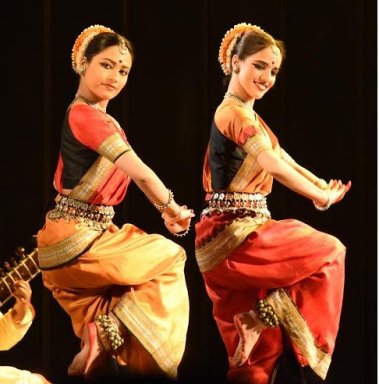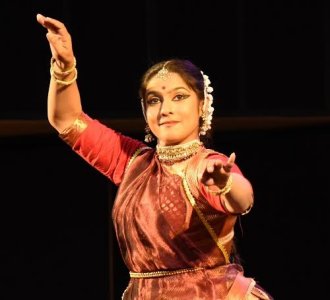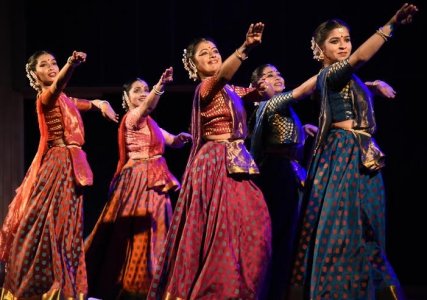
|   |

|   |
Padhant as puja: The Sarngadeva Samaroh - Shveta Arora e-mail: shwetananoop@gmail.com Pics: Anoop Arora April 16, 2016 On the 29th of February and the 1st of March, Sarngadeva Samaroh was held by Aurangabad based Mahagami, at the India Habitat Centre in Delhi. The Sangeeta Ratnakara of Sarngadeva (13th century) is a music treatise that is important to both Hindustani and Carnatic musicians. The first six chapters deal with music, and the last one deals with dance.  Madhavi Mudgal  Madhavi Mudgal’s disciples On 29th February, Madhavi Mudgal performed with her disciples. She began with an invocation to Lord Shiva, a mangalacharan, a composition from Sangeeta Ratnakara, with music composed by late Pandit Abhiseki. The Behag pallavi was choreographed by Guru Kelucharan Mohapatra, with music by Pandit Bhubaneswar Mishra. The solo by Madhavi saw some pure nritta executed with excellence, and delicate footwork, rhythmic and controlled. The abhinaya was based on an ashtapadi “Kisalaya shayana” from Geeta Govind. The poetry says that Radha is annoyed with Krishna and he tries to appease her. He tells her to place her lotus feet on a bed of new tender leaves so that he can press them. He asks if he can remove her anklets and caress her feet. The music was by Madhup Mudgal and choreography by Madhavi Mudgal. The Ragamalika pallavi used ragas Hamir, Kamod, Kedar and Chhayanat. The choreography was by Madhavi Mudgal and music by Madhup Mudgal. The complex patterns of the pallavi were performed by Shalakha Rai and Shobha Bisht. Another abhinaya piece was based on poetry by the famous Odiya poet Gopal Krishna Pattanaik. The nayika here is a virahotkantitha nayika, who is awaiting Krishna’s arrival. The nayika in her separation is talking to the bhramar, the bee: “Did you see him? Has he sent you a message for me? It is the bee that seeks the lotus, the lotus does not come to it, just as I am pining for Krishna.” She is desperate and confused and the sakhi chides her for speaking to an insect who does not understand her feelings. Madhavi depicted the nayika waiting in the kunj or the bower when the bee comes. She follows it around. Krishna here is shown as the one who bears the mountain on his little finger, the one who danced on the hood of the Kaliya snake. The abhinaya was depicted with all the subtlety the piece required. The concluding group choreography Madhurashtaka was a composition by poet Vallabhacharya. The lyrics describe the attributes and beauty (madhurta) of Krishna - his lips, his body, his eyes, his smile, his words, his leelas, his clothes, his gait, his flute, the dust under his feet, his hands, his feet, his dance, his friends, his songs, his tilak, his gunjamala, the river Yamuna and its shores, its water, the blooming lotuses, the gopis, his srishti (creation) and his nurturing and destroying of it are all lovable and adorable. Choreographed by Madhavi Mudgal with music by Madhup Mudgal, the group depicted the piece with impressive footwork, ending with the stance of Krishna with his sakhis and cows. The dancers were Sudha Mukhopadhyay, Shalakha Rai, Shobha Bisht, Prerna Agarwal and Dipika Bisht. On the pakhawaj was Jitendra Kumar Swain, Gandhi Mallik on the manjira, Manikuntala Bhowmik and Kshitij Mathur on vocals, Kiran Kumar on the flute, Yar Mohammad on the sitar, Diwan Singh on the tanpura, and the lighting was by Sandip Dutta.  Parwati Dutta  Parwati Dutta’s disciples The next day, it was the turn of Parwati Dutta and her disciples. Visitors were greeted by a white coloured rangoli in the foyer of the venue. Parwati is a versatile Odissi and Kathak dancer, and director of the Mahagami Gurukul in Aurangabad. Pakhawaj taal is the taal of bhakti. “It is an invocation of Naad Brahma. The manifestation of Naad Brahma can also be visualized and understood as light or Surya Dev. For this, I took an ancient poetry written in the 7th century invoking Surya and describing it in a poetic manner. The verse says that the rising sun shines like a diamond on the head of a serpent, as if the entire universe is a sapphire tree and a golden leaf is the sun. For all those yogis who are trying to cross the sea of this world, the sun is like the mangal kalash, which is a symbol of an auspicious journey,” explained Parwati. “I am more inclined towards the dhrupad and pakhawaj, and I try to revisit and revive these ancient glorious traditions of Kathak. I took a few pieces of the temple tradition as a part of my repertoire.” The composition in taal Vasant was a piece based on the energy of Vasant, beginning with a shloka and then paran and uthaan, all in nau maatra to a lot of rhythmic patterns. It was performed to “Charu Taram Vasante,” a composition by Kalidasa. Describing the season, the words say that the trees are laden with blossoms, the air is pleasantly scented. Parwati’s disciple performed the piece with chakkars and deft footwork. The composition by Tansen about the rainy season was in dhrut taal in dhrupad using tatkar, paran and layakari – “Indra Aayo Re.” It had some excerpts from Govardhan Leela. The piece depicted the lifting of the Govardhan mountain. When the wrath of Indra befalls Vrindavan, Krishna lifts the mountain on his little finger and saves the people of Vraj from the torrents of rain, sheltering them under the hill. “It is a different form of music and so the music rendition needs to have that kind of vigour, poetic majesty and grandeur, because dhrupad verses have different kind of words. I was also trying to think of different kinds of movements to go with the verses,” said Parwati. Following that was an expressive abhinaya piece based on a thumri “Mooratiya man mein basi ghanshyam” (I looked for you everywhere, in Gokul and Vrindavan, and found you in my heart). The final piece ‘Varnareeti’ had a very interesting theme about how the varnas in Kathak have a reeti (method), which is like upasana (worship); that is, the padhant is not meaningless utterance. Each syllable has a meaning. The pakhawaj bol - ‘din’ - is like the suryodaya or the rising sun, and ‘dhan’ is dhyan (meditation). Every beat and every bol, every taal of pakhawaj, denotes a meaning. The group choreography was executed well with flawless technique. The piece ended with the chanting of ‘Om ganagadi’ like a mantra. In a nutshell, Parwati condensed her presentation thus. “Once, Kathak was a temple tradition, katha vachan (storytelling) was an important part of Kathak. Padhant or recitation is still an important aspect of Kathak. I wanted to bring all these elements together - the sound of ghungroos, the syllables, the sound of pakhawaj, of utterances. I wanted it to be a sacred offering. I begin with a Ganesh paran - just recitation, as that’s how dancers would begin in the ancient times, with recitation or padhant. It was an attempt to relive that ancient practice, so I used a lot of metaphors from pakhawaj. ‘Dhaan’ is dhyaan, ‘din’ is sunrise, the light of knowledge, realisation, and then I tried to weave it into a jap or repetitive mantra. I don’t want to connect it to any religion (on being asked if these are offerings to the Lord), but these utterances have a divine power. According to the scriptures, we know about the beejakshar, the power of the mantra, the power of utterances. If we refer to the Natya Shastra, they refer to shushkakshara and stobhakshara. These are ritualistic utterances. There was always a practice of uttering them before a performance to sanctify the dancing space, to pacify the negative energy and to bring in positivity. The Natya Shastra and Sangeeta Ratnakara, according to research, connect the dancer directly to the recitation or padhant. As a Kathak practitioner, I feel they are not just bols (spoken beats). It is abstract poetry, which is meant to sanctify the space. Personally, when I do the padhant, I get a kind of energy and inspiration. That is the light or power - the padhant is a puja.” Performing with Parwati were her students from Mahagami Gurukul - Anamika Sarkar, Shreeya Dikshit, Sheetal Bhamre, Snehal Katare, Deepa Karta and Kannagi Gosvi. As a blessing to Parwati, Pandit Birju Maharaj gave a short performance at the end. Maharaj can attribute a lot of meaning to the bols of padhant. He said trees are like dancers. Sometimes, the bols are recited as if somebody is writing a letter. Then he went on to describe how the bols can show a bird feeding its fledglings in the nest. The pakhawaj was by Sukhad Munde, and sarangi by Sandeep Mishra. Shveta Arora is a blogger based in Delhi. She writes about cultural events in the capital. |